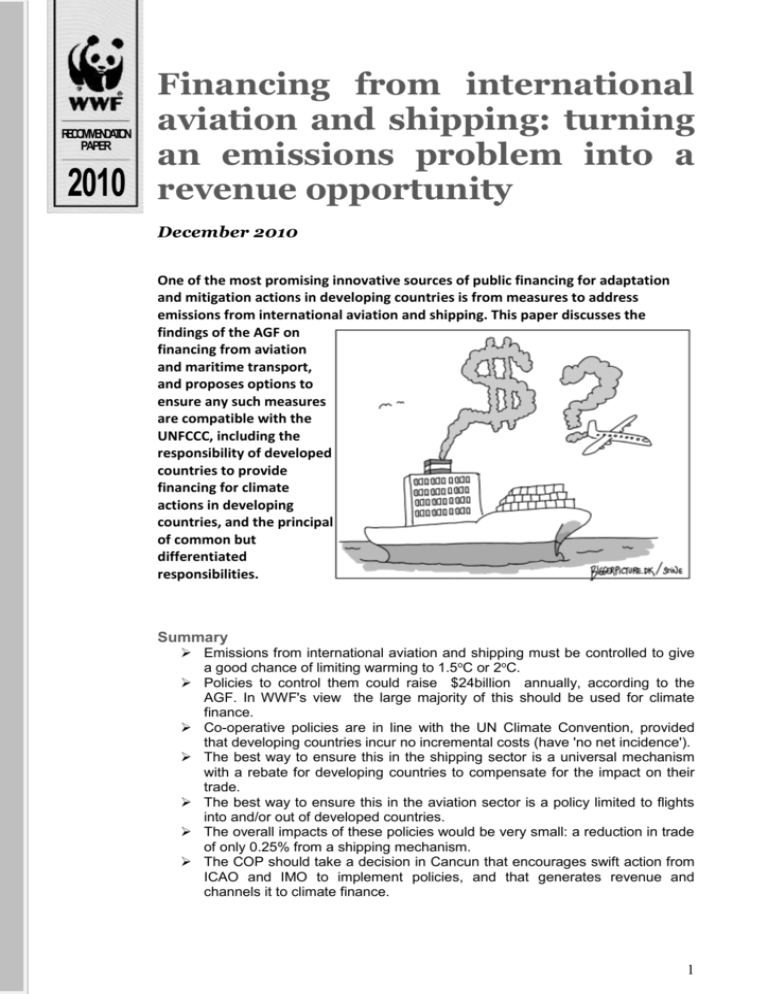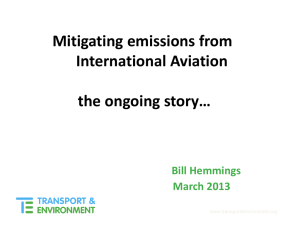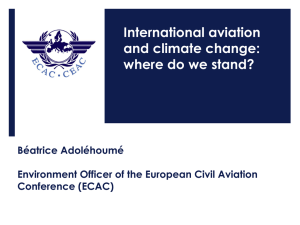
RECOMMENDATION
PAPER
2010
Financing from international
aviation and shipping: turning
an emissions problem into a
revenue opportunity
December 2010
One of the most promising innovative sources of public financing for adaptation
and mitigation actions in developing countries is from measures to address
emissions from international aviation and shipping. This paper discusses the
findings of the AGF on
financing from aviation
and maritime transport,
and proposes options to
ensure any such measures
are compatible with the
UNFCCC, including the
responsibility of developed
countries to provide
financing for climate
actions in developing
countries, and the principal
of common but
differentiated
responsibilities.
Summary
Emissions from international aviation and shipping must be controlled to give
a good chance of limiting warming to 1.5oC or 2oC.
Policies to control them could raise $24billion annually, according to the
AGF. In WWF's view the large majority of this should be used for climate
finance.
Co-operative policies are in line with the UN Climate Convention, provided
that developing countries incur no incremental costs (have 'no net incidence').
The best way to ensure this in the shipping sector is a universal mechanism
with a rebate for developing countries to compensate for the impact on their
trade.
The best way to ensure this in the aviation sector is a policy limited to flights
into and/or out of developed countries.
The overall impacts of these policies would be very small: a reduction in trade
of only 0.25% from a shipping mechanism.
The COP should take a decision in Cancun that encourages swift action from
ICAO and IMO to implement policies, and that generates revenue and
channels it to climate finance.
1
Need to reduce emissions
International aviation and shipping are major and fast-growing sources of greenhouse gas
emissions. The sectors' combined emissions were over 1 GtCO2 in 2007 and are expected to rise
to around 1.7 GtCO2 in 2020, not counting the additional non-CO2 warming impacts of aviation.
Business-as-usual projections by the International Civil Aviation Organisation (ICAO) and
International Maritime Organisation (IMO) suggest that in the absence of policies to control them,
emissions could triple by 2050. Such unchecked emissions would take up a substantial proportion
of any global carbon budget, and undermine the chances of avoiding temperature rises of 2 oC , let
alone 1.5oC.
Bunker1 Finance from mitigation policies for aviation and shipping sectors
Measures that target these emissions, by putting a price on aviation and shipping carbon
emissions, either through an Emissions Trading Scheme (both sectors) or a fuel levy (for shipping),
could raise substantial revenues. These measures are under active discussion at IMO and ICAO.
An air passenger levy (ticket tax) would target emissions less directly, but would still raise
significant revenue. Money raised by any such measure could then be used to support climate
change adaptation and mitigation in developing countries.
The UN High-Level Advisory Group on Climate Finance (AGF) examined the possible revenues
from the sectors. The AGF found that up to $18 billion could be raised overall from shipping and up
to $6 billion from aviation, at a carbon price of $25/tCO2, but went on to state that only a quarter to
a half of this revenue is likely to be used for climate finance – yielding a range of $4-9 billion for
climate from shipping and $2-3 billion from aviation. The AGF recommendations are examined in
more detail below.
Should measures be global or apply to developed countries only?
Aviation and shipping are quintessentially global sectors and the bulk of their emissions take place
in international waters or airspace. SBSTA first discussed the question of how to allocate these
emissions to Parties in 1996, but there has been no substantive debate on the issue for several
years. In effect, Parties are agreed that the emissions cannot be attributed to individual countries.
With no agreed definition of which emissions belong to which Parties, it has proved difficult to
design any policy that applies to 'Annex I emissions' only, since there is no way to decide what
constitutes 'Annex I emissions'. The most appropriate place to tackle these emissions is by
negotiating an outcome based on the mandate provided by paragraph 1 b (iv) of the Bali Action
Plan, which seeks to implement Article 4 of the Convention on co-operative sectoral approaches.
Article 4.1 of the Convention provides that 'all Parties shall promote and cooperate in the
development, application and diffusion, including transfer, of technologies, practices and processes
that control, reduce or prevent anthropogenic emissions of greenhouse gases [...] in all relevant
sectors, including [...] transport'.
Article 4.3 stipulates that developed country Parties 'shall also provide such financial resources,
including for the transfer of technology, needed by the developing country Parties to meet the
agreed full incremental costs of implementing measures' referred to in Article 4.1.
Co-operative policies on bunker fuels, then, can:
1
reduce greenhouse gas emissions;
raise finance for climate action in developing countries; and
be compatible with the Convention, provided that these policies conform to UNFCCC
principles, including that of “common but differentiated responsibilities and respective
capabilities (CBDRRC)”, and that developing countries do not incur net costs as a result of
measures to generate climate finance. The same concept is discussed in the AGF report in
terms of ensuring 'no net incidence' on developing countries and this paper will adopt that
terminology.
“Bunkers” is the term for the fuels used in international aviation and maritime transport.
2
Ensuring no net incidence on developing countries
Net incidence on developing countries can be eliminated in one of two ways: restricting the scope
of the policy, or compensating developing countries (separately to any climate finance element).
The two sectors should be considered separately in order to find the most appropriate solution for
each.
In the case of shipping
The IMO operates on the principle of 'no more favourable treatment of ships'. In other words, ships
of all flags should be treated equally under any given policy. This is a strongly advisable approach,
as it is very straightforward to change the flag of a ship. Already three-quarters of the global fleet is
flagged in developing countries and the remaining quarter would readily re-flag if faced with a
carbon cost applied only to Annex I ships. Although a majority of shipping is currently controlled by
companies registered in Annex I countries, they could also quickly relocate if it became
advantageous to do so. So nationality of ownership is of little benefit as a basis for differentiation.
It has been suggested that policies could be applied only to ships sailing to Annex I ports. This
might be feasible, but it could also invite evasion. For instance, a ship headed from Asia to Europe
could dock briefly in North Africa, so that only emissions on its final leg fell within the policy.
Applying the policy to emissions from any cargo destined for Annex I countries could get around
this problem, but would be extremely complex, especially as in practice ships will often discharge
part of their cargo and/or take on extra goods in one port, and then another, before continuing to
their final destination.
So for practical reasons it is preferable for any maritime policy to apply universally, and hence all
options under discussion at IMO are global policies. One possible exception is to set a minimum
(“de minimis”) threshold to exclude routes to the most remote island states. Such a measure would
be very unlikely to lead to serious carbon leakage, but could serve to protect vulnerable countries
most reliant on seaborne imports from any rise in the price of goods. (See 'Impacts' section below.)
In the case of a universal maritime policy, net incidence on developing countries could be
eliminated through a rebate mechanism. Funds from a fuel levy or auction revenues from an ETS
would be collected centrally, and a proportion would be redistributed directly to developing country
governments to offset the economic impact of the policy. In the proposal under discussion at IMO,
the basis for this rebate is a country's share of global imports by value. (Other redistribution keys
are possible, eg share of exports, or a weighted average of imports and exports.)
So for example, assume a maritime policy raises $25 billion, and South Africa's share of global
imports is 0.6%. South Africa would receive a rebate of $150 million from the central fund. The total
rebate to all developing countries would be approximately 30% or $7.5 billion. The remaining
revenue of $17.5 billion would be available for three purposes: climate finance; technology support
for the maritime sector, and central government revenue. WWF believes that only a small slice (say
10%) should go to the shipping sector, and none to central governments (who accept no
responsibility for the emissions). The AGF, however, assumes that only between 25% and 50% of
revenues could be earmarked for climate finance. Thus their estimate is that shipping could
generate $4-9 billion per year, when in fact it could generate $16 billion (with a further $2 billion
supporting clean development of the maritime sector in developing countries).
In the case of aviation
ICAO operates a policy of 'non-discrimination' between airlines. This means it is not possible to
apply a policy to airlines of one country but not another – and in any case this would lead to a
distortion where airlines compete on the same route.
However, it is much more feasible in aviation than in shipping to apply a policy only on certain
routes. The EU has studied the impacts of a regional ETS (all flights within, into and out of the EU)
and concluded that any leakage or distortion is likely to be small. Aircraft cannot readily alter their
routes in the way ships can, and it is uneconomical for them to carry more fuel than is needed for
the current leg.
3
Therefore, to eliminate incidence on developing countries, the AGF suggests excluding all flights
between developing countries, and half of flights between developed and developing countries (in
practice, as almost all flights are return trips, it make little difference whether flights from developed
into developing countries are excluded, or the other way around). This would be effective in
eliminating incidence on developing countries, but it does reduce by around 50% the pool of
emissions to which the policy applies – reducing its environmental effectiveness.
Another option is under discussion at ICAO. Resolution A37/17-2 [ref], passed by the recent ICAO
Assembly (but subject to an unprecedented number of reservations by States) suggests an
approach based on a de minimis threshold: states with less than 1% of global aviation activity
would be exempt from market-based measures2. This would mean that measures apply to only
around 25% of States, but capture around 80% of emissions. Another benefit of this approach is
that it is flexible over time. As a country develops in relative economic terms, its aviation sector
may exceed the 1% threshold, triggering inclusion in the scheme.
Whatever scope of emissions policies are applied to, the revenue generated will be subject to the
same claims as for shipping: between climate finance, the aviation sector and governments. The
AGF assumes again that only 25% to 50% could be made available to climate finance. Combined
with the reduced scope of application, this reduces their estimates of revenues from aviation to $23 billion. If 90% of revenue is used for climate finance, with 80% of international aviation covered,
around $6 billion could be generated for climate action.
Impacts of mitigation schemes
The overall impact of an aviation policy would be small, as a carbon price applied to tickets would
only push up the price by a small fraction of their existing cost (examples given by the AGF are
increases of 2% and 3%); it would be progressive, as it is overwhelmingly the globally wealthy who
are able to afford air travel; and in any case it is feasible to restrict the scope of the policy to
exclude any incidence on developing countries.
A universal shipping policy would have some impact on trade, but studies to date suggest that the
overall impact would be small. A recent study by a specially-convened IMO Expert Group stated
that the overall reduction in trade would be below 0.2%; AGF put it at 0.25%. (This is partly
because shipping is an extremely carbon efficient mode of transport per tonne-km, so imposing a
carbon price leads to only a very small increase in the cost of a tonne of goods.)
The distributional effects may be more noticeable. These occur when an exporter competes with a
producer located in (or closer to) the target market. The increased cost of goods gives a marginal
advantage to the local over the distant producer, and the effect varies with the elasticity of the
good. In two examples quoted by the AGF:
one would reasonably expect US consumers to pay the full cost of a carbon price on bunker
fuels for both the laden voyages from the Middle East to the US and for the return journey
of an oil tanker (reflecting the elasticity of demand and supply of oil). By contrast, Japanese
auto exporters would be likely to bear at least some of the additional carbon cost of
transport to the US reflecting the strong competition in the auto market from domestic US
manufacturers and from other (closer) competing nations including in Europe.3
Even where these effects occur, however, they are not likely to alter trade flows by more than a few
percentage points, given the carbon efficiency of shipping and the low impact of a carbon price per
tonne of goods moved. Gi (MARK –What does gi MEAN HERE OR IS IT NOT MEANT TO BE
THERE)
2
Unfortunately, the resolution applies the exemption to the aircraft carriers registered in those countries,
which seems to fly in the face of ICAO's non-discrimination policy. An exemption for any flight to such a country
would be a better measure, possibly combined with rules to exclude very small aircraft operators (as happens
with the EU ETS).
3
AGF Workstream paper 2 on International Transport, page 12.
http://www.un.org/wcm/webdav/site/climatechange/shared/Documents/AGF_reports/Work_Stream_2_Intern
ational_Transport.pdf
4
A decision in Cancun
ICAO and IMO are the bodies with the technical expertise to design and implement bunker policies,
and discussions are already well advanced – especially at IMO, where a number of substantive
proposals have been thoroughly evaluated. ICAO's approach has been to focus on the political
rather than the substantive elements of market-measures, and consensus has proved difficult to
achieve, although the acknowledgement of regional measures in the recent Assembly resolution
may open the way to action by a coalition of the willing.
However, progress in IMO and ICAO remains much too slow, and they have been unable to
resolve issues related to CBDR, on which they would benefit enormously from guidance from the
COP.
Therefore a COP 16 decision should express the following:
Parties should co-operate to reduce international bunker emissions, working through ICAO
and IMO.
IMO and ICAO should be encouraged to develop as speedily as possible measures to
reduce emissions. Ideally, as the body with overall responsibility for climate protection, the
COP should set a target, or reserve the right to set a target in future.
In developing policies, ICAO and IMO should be guided by their respective conventions and
customary practices, while taking into account the interests of developing countries. This
will give them the flexibility to develop appropriate solutions for their sectors, while ensuring
there is no net incidence on developing countries.
The vast majority of the revenues from such policies should be used for climate finance in
developing countries. This will ensure that bunkers policies are not only neutral for
developing countries, but generate a much-needed stream of revenue to finance adaptation
and mitigation projects.
Conclusion
International aviation and shipping are mitigation problems of major concern – they are large and
fast-growing sources of emissions with no overall regulatory framework to control them. Policies to
control them could pay a double dividend – reducing emissions but also unlocking major flows of
climate finance.
Delivering such policies will require substantial political will, as the sectors are not amenable to
rigid distinctions between Annex I and non-Annex I. But since their emissions do not belong to any
Party, co-operative action to tackle them need not set a precedent for the treatment of emissions
that do belong to individual Parties. Furthermore, Article 4 of the Convention provides a clear
mandate for such co-operative sectoral approaches, provided there is no net incidence on
developing countries – and this is feasible.
Emissions problem or revenue opportunity? The choice is yours....
Why we are here
To stop the degradation of the planet’s natural environment and
to build a future in which humans live in harmony with nature.
www.panda.org/climate
® WWF Registered Trademark Owner
Contact: Mark Lutes
Finance Policy Coordinator
WWF Global Climate Initiative
E : mark.lutes@wwf.panda.org
Mobile: +1 416 473 5919
© 1986, WWF – World Wide Fund For Nature
© 2010, WWF All rights reserved
(formerly World Wildlife Fund), Gland, Switzerland
5







